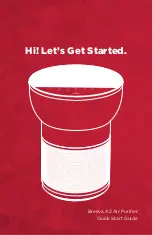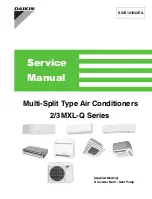
22
Connecting the Refrigerant Pipe
There are two refrigerant pipes of differing diameters:
A smaller one for the liquid refrigerant.
A larger one for the gas refrigerant.
The inside of copper pipe must be clean & has no dust.
The connection procedure for the refrigerant pipes varies
according to the exit position of the pipes from the indoor
unit, as seen when facing the indoor in the “A” side.
Liquid refrigerant port.
Gas refrigerant port.
Drain hose port.
A
※
The designs and shape are subject to change according to
the model.
1.
Remove the pinch pipe on the pipes and connect the
assembly pipes to each pipe, tightening the nuts, first
manually and then with a torque wrench, a spanner
applying the following torque.
Refrigerant oil
Torque wrench
Flare nut
Union
Spanner
Outer Diameter
(mm)
Torque
kgf•cm
N•m
6.35
140~180
14~18
9.52
350~430
34~42
12.70
500~620
49~61
15.88
690~830
68~82
Must apply refrigerant oil on the flaring area to prevent
a leak.
Note
2.
Be sure that there must be no crack or kink on the bent
area.
LEAK TEST WITH NITROGEN (before opening valves)
In order to detect basic refrigerant leaks, before recreating
the vacuum and recirculating the R-410A, it’s responsible of
installer to pressurize the whole system with nitrogen (using
a pressure regulator) at a pressure above 4.1MPa (gauge).
Leak test
Performing Leak Test & Insulation
• Discharge all the nitrogen to create a vacuum and
charge the system.
• All refrigerant connection must be accessible, in
order to permit either unit maintenance or removing
it completely.
LEAK TEST WITH R-410A (after opening valves)
Before opening valves, discharge all the nitrogen into the
system and create vacuum. After opening valves check leaks
using a leak detector for refrigerant R-410A.
Once you have checked that there are no leaks in the
system, you can insulate the piping and hose.
1.
To avoid condensation problems, place
T13.0 or thicker
Acrylonitrile Butadien Rubber
separately around each
refrigerant pipe.
Always make the seam of pipes face upwards.
Note
2.
Wind insulating tape around the pipes and drain hose
avoiding to compress the insulation too much.
3.
Finish wrapping insulating tape around the rest of the pipes
leading to the outdoor unit.
4.
The pipes and electrical cables connecting the indoor unit
with the outdoor unit must be fixed to the wall with
suitable ducts.
Insulation
Check for leakage
Must fit tightly against
body without any gap.
Be sure to overlap
the insulation
Indoor unit
Leak check
Insulation pipe
Insulation cover pipe
NASA_Floor Stand_AM@@@FNFDEH@_IB,IM_EN_03677A-05.indd 22
2016-04-06 오후 2:25:14
















































